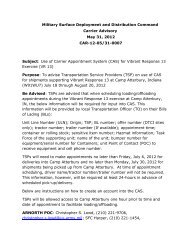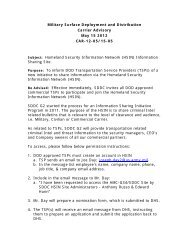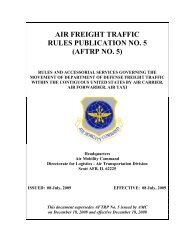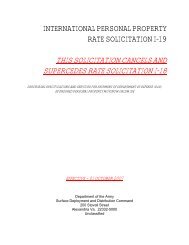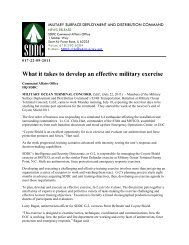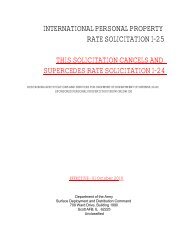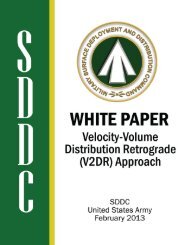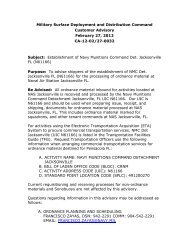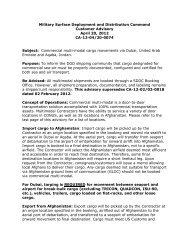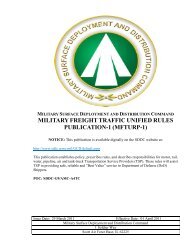597th Transportation Brigade Newsletter Oct 2012 - SDDC - U.S. Army
597th Transportation Brigade Newsletter Oct 2012 - SDDC - U.S. Army
597th Transportation Brigade Newsletter Oct 2012 - SDDC - U.S. Army
You also want an ePaper? Increase the reach of your titles
YUMPU automatically turns print PDFs into web optimized ePapers that Google loves.
By Gary Tripp & Michelle Montieth<br />
<strong>597th</strong> Safety and Occupational Health<br />
Manager; <strong>597th</strong> Public Affairs<br />
JOINT BASE LANGLEY-EUSTIS, Va.<br />
— The brigade takes the theme, “Safety<br />
is Everyone’s Business”, and makes it a<br />
reality.<br />
According to the Bureau of Labor Statistics,<br />
in 2011, the transportation industry<br />
had about six accidents per year, per<br />
100 employees, resulting in hospital time.<br />
With more than 400 Soldiers and civilians<br />
working within the <strong>597th</strong>, that would<br />
mean that the Bureau would expect approximately<br />
24 accidents per year. Yet,<br />
how many did the <strong>597th</strong> have? Zero—<br />
None—Zip. In fact, in 2011, all seven<br />
subordinate units qualified for both the<br />
<strong>Army</strong> Safety Excellence Streamer and the<br />
<strong>Army</strong> Accident Prevention Award.<br />
Receiving the streamer is difficult, but<br />
qualifying for the award is even more difficult.<br />
In addition to having no Class A<br />
(deaths) or Class B (three people hurt during<br />
an accident) accidents, the <strong>Army</strong> Accident<br />
Prevention Award means the unit<br />
had zero Class C accidents—those which<br />
result in lost work days. Thus, 0 percent<br />
compared to 6 percent is huge in safety.<br />
An Occupational Safety and Health Administration<br />
inspector once stated that hitting<br />
a home run during an inspection required<br />
key safety programs to be in place.<br />
At the beginning of an OSHA inspection,<br />
the examiner would ask for the accident<br />
log. If the organization could not produce<br />
it, then the organization didn’t even make<br />
it to first base and might as well sign a<br />
blank check because it was going to be<br />
a long inspection. However, if the unit<br />
did have it, then leader involvement in<br />
its safety program would get it to second<br />
base. Third base meant having training<br />
programs in a few key areas. And, a home<br />
run was having written programs in most<br />
of the areas inspected.<br />
Safety<br />
www.facebook.com/<strong>597th</strong><strong>Transportation</strong><strong>Brigade</strong> Capability Review Vol. 2, Issue 1 <strong>Oct</strong>ober 24, <strong>2012</strong> 9<br />
Hitting a safety home run<br />
Some are under the impression that OSHA<br />
regulations do not apply to the military.<br />
There are two sources for the <strong>Army</strong>’s<br />
safety program requirements: OSHA and<br />
<strong>Army</strong> Regulation 385-10, the <strong>Army</strong> Safety<br />
Program. AR 385-10 addresses the safety<br />
functions not covered by OSHA. Executive<br />
Order 12196 states that the military<br />
will adhere to OSHA standards with the<br />
exception of personnel reporting of Soldiers<br />
and military-unique missions. Soldiers<br />
are not included in OSHA’s personnel<br />
reports because OSHA only considers<br />
accidents and injuries at work whereas the<br />
<strong>Army</strong> includes on- and off-duty accidents<br />
and injuries. Also, military-unique missions<br />
are not covered by OSHA as it would<br />
be inappropriate to hinder missions—possibly<br />
affecting national defense.<br />
Leadership involvement is the <strong>Army</strong>’s<br />
most important element of any safety program.<br />
If leaders of a unit are not actively<br />
engaged in safety, the best written programs<br />
will be hallow and useless. A commander’s<br />
involvement includes participating<br />
in safety councils, having written<br />
safety policies, reviewing and signing risk<br />
assessments, conducting safety inspections<br />
and evaluating accident reports.<br />
When developing a solid safety program, a<br />
comprehensive training program is how a<br />
unit gets to second base. Although OSHA<br />
has a long list of requirements, inspectors<br />
usually focus on four areas required of all<br />
organizations: new employee orientation,<br />
fire evacuation plans, personal protective<br />
equipment and hazard communication.<br />
Many of the other programs are considered<br />
“as needed”; all dependent upon the<br />
hazards of the working environment.<br />
Since ship operations are a major recurring<br />
mission for units within the <strong>597th</strong><br />
<strong>Transportation</strong> <strong>Brigade</strong>, Military Surface<br />
Deployment and Distribution Command,<br />
Gary Tripp, the <strong>597th</strong> safety and occupational<br />
health manager, conducts the<br />
10-hour OSHA Maritime Safety course.<br />
This 2-day training, focusing on longshore<br />
and terminal safety, includes topics<br />
such as an introduction to OSHA, walking<br />
and working surfaces, personal protective<br />
equipment, fall protection/scaffolding,<br />
electrical, confined and enclosed spaces,<br />
control of hazardous energy and fire protection.<br />
Although several of these topics<br />
are already part of the <strong>Army</strong>’s required<br />
annual training, upon completion of this<br />
additional training, participants receive<br />
OSHA certification cards through the University<br />
of Southern Florida. In addition to<br />
classroom instruction, students receive<br />
hands-on training by identifying possible<br />
hazards on a Land Craft Utility ship at 3rd<br />
Port here.<br />
“Having a good written safety program<br />
is important,” said Tripp. “But, having a<br />
good safety culture is even better. With a<br />
safety culture, you have safety awareness,<br />
engaged leadership and everyone working<br />
together to ensure safe conditions. It’s<br />
easy to say, ‘Everyone is a safety officer.’<br />
However, if Soldiers are not trained in<br />
safety standards, the statement has no<br />
meaning. The OSHA Maritime Safety<br />
course provides Soldiers with the tools<br />
to know what right looks like. I do not<br />
expect Soldiers to know that a bull rail installed<br />
before 1983 should be six inches<br />
versus the current 10 inches. However, I<br />
am hoping that when Soldiers arrive at the<br />
pier and look around, they would raise a<br />
safety flag if the bull rail was missing. It’s<br />
a win-win situation when we eliminate<br />
hazards and maintain a safe work environment.”<br />
“The Maritime Safety course is specific to<br />
the environmental safety of the RPOE’s<br />
SPOD (Rapid Port Opening Element’s<br />
Seaport of Debarkation) mission, but it<br />
also reinforces safety habits that should<br />
be used on a daily basis,” said 2nd Lt. Brian<br />
M. Kavanagh, the 689th RPOE clearance<br />
officer in charge. “Two topics that<br />
I think are particularly important were<br />
HAZCOM and PPE. Every Monday, we<br />
conduct command maintenance. Any observer<br />
or participant in the motor stables<br />
would see Soldiers engaging in activities<br />
that require the use of PPE and an awareness<br />
of HAZCOM.”<br />
“Mr. Tripp was very thorough with his<br />
class and made sure everyone understood<br />
the importance of maritime safety,” said<br />
Pfc. Leslie A. Owens, a 689th RPOE supply<br />
clerk. “He showed us the consequences<br />
that could erupt if you were not careful<br />
and thinking about safety.”<br />
In addition to OSHA, the <strong>Army</strong>’s safety<br />
training requirements are based on military-unique<br />
situations and the fact that<br />
Soldiers are Soldiers 24/7. The main training<br />
requirements for all <strong>Army</strong> personnel<br />
include employee/supervisor safety training,<br />
accident avoidance, also called defensive<br />
driving, and Composite Risk Management.<br />
Depending upon the nature of<br />
the unit’s mission, other training requirements<br />
may apply.<br />
CRM is the <strong>Army</strong>’s primary decisionmaking<br />
process to identify hazards, reduce<br />
risk and prevent loss. The <strong>597th</strong><br />
makes safety priority one by incorporating<br />
CRM into daily operations. The experts—<br />
operators and supervisors—can identify<br />
hazards, implement controls and conduct<br />
missions in the safest possible manner to<br />
ensure the safety of Soldiers and Department<br />
of <strong>Army</strong> civilians.<br />
See HOME RUN, Page 16



